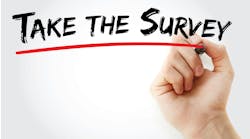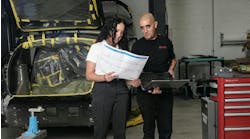Content brought to you by ABRN. To subscribe, click here.
What you will learn:
• Paint products include sundry items used in refinishing
• Why you should categorize purchases into four buckets
• Why the estimating system's paint materials calculator is not accurate
When I’m asked about paint profitability, I often ask if they are talking about liquid products or materials. Surprisingly, some think they are one and the same, but they are quite different. Liquid products are primers, sealers, basecoat colors, clears and additives like pearls, while materials are the sundry items used in the preparation for refinishing. An excerpt from CCC/MOTOR P-pages indicates, “Paint Supplies or Paint Materials is the actual paint, or clearcoat, and the tapes, gap-filling materials, masking paper, sandpaper, cleaners, thinners, and additives used during the refinish process.” The key words here are “used during the refinish process.” The issue I have seen is people convinced that paint is what is used in the refinish process and materials are what is used in the body repair process. That could not be further from the truth. Allow me to explain why.
As indicated in the CCC/MOTOR P-pages, the paint material allowance on a damage appraisal only covers the products used during the refinishing processes. All products used in body repair are additional items that should be billed independently of your paint material allowance. That is where some confusion lies when trying to calculate paint material profitability. I have seen shops subtract their jobber invoices from the dollars received for paint materials to calculate their profits. If that is how you measure your paint material profitability, it will be a very low percentage.
Categorize your purchases into four buckets
It is critical that your purchases are broken down into four buckets: liquid (all paint products), refinish sundry items, body sundry items, and tools/miscellaneous. The only two items that should be included in paint material profitability calculations are liquid and refinish sundry items. Body sundry items are separate expenses that could be considered consumables or preferably billed as parts on damage appraisals. Categorizing items like seam sealers, adhesives and corrosion protection products as parts allows for independent billing and reduces the opportunity for them to be included in paint material profitability calculations.
Maintain profitability with a 70/30-percent balance of liquid and refinish sundry items
Getting back to paint material profitability, you should maintain a balance of 70 percent liquid and 30 percent refinish sundry items to optimize profitability. If your liquid is higher, there is a good chance that too much paint is being consumed. If it is lower, too many refinish sundry products are possibly being used. The first way to validate this is to make sure everything is in the right bucket, and for accuracy you should always measure the 70/30 split at refinish list pricing. It doesn’t take much to skew the numbers, so a small incorrect posting can alter your percentages quickly.
Examine reports for low profit percentages on individual repairs
The next step is to review paint mixing reports from your computerized mixing system to look for low profit percentages on individual repairs. When looking at paint mixing reports, I review basecoat color category in comparison to clearcoat. Basecoat and clearcoat should be almost the same. I will often multiply the base ounces by 1.2 and if the clear ounces are higher, I consider it excessive. The next check would be to divide the cost by the hours identified on the repair. If it is above $18.00, then either too much paint was mixed for the repair, or all the areas refinished were not identified on the repair order. Either one is considered waste and only adds to your liquid costs and reduces profitability.
The estimating database’s paint materials calculator is not accurate
The other area that affects paint material profitability is relying on the paint materials calculator in your estimating database. It has not been accurate for some time, and I encourage you to read my ABRN article, “How to collect for today’s paint materials” that was published in August 2022 to find ways to bill for additional paint materials.
It is clear that paint material profitability is a little more complicated than adding and subtracting or comparing your purchases to sales. Paint profitability begins in the front office with accurate damage appraisal documentation to ensure all paint operations are captured, followed by proper mixing procedures and accurate billing of materials. I have shown you a couple of ways to validate your profitability as well as some checks you can make when your profitability is low. Remember that the key is to only use your liquid and refinish sundry costs when calculating profitability. I hope this article has given you some things to ponder, and as you put them into practice you will discover profits you thought were lost that can now help sustain the long-term success of your business.




